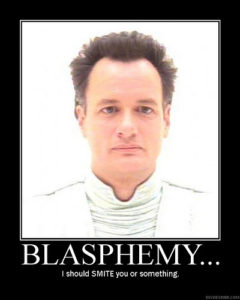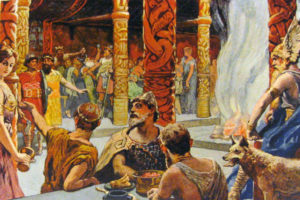A Heathen’s View of the Afterlife
The end of the year/beginning of this year saw the death of an in-law and got me thinking about the afterlife. The in-law in question was very Catholic and requested that they have a funeral and burial in the Catholic tradition. That meant a vigil (aka a wake), funeral mass, and then a ceremonial burial. It was odd to go through the entire process because I ended looking at it from a Heathen perspective.
 Churches and Whatnot
Churches and Whatnot
First, the church. A Roman Catholic church which was heavily modernized. If you took away the crucifix on the stand and the portrait of Jesus, it looked like something you’d see as a pagan temple with trees and even a walk-in fountain. There were only chairs and no pews. In other words, it wasn’t what I experienced while growing up.
The sermons and eulogy had the typical “they’re with Jesus” bullshit. I expected that. But I saw the camaraderie among the church goers that made me think of how the church was looked at during Medieval times. You see, the Catholic church was not just a place of worship, but it was also a way for people to socialize the way they do now. They heard the latest church music, they saw the latest fashions, and yes, it gave them a way to connect with their neighbors. I saw that at the funeral and the luncheon that followed afterward where people brought what they made to share with us. So, I get why the Christian churches are popular. They provide a sense of community as well as a promise of an eternal life.
What About the Heathen Afterlife?
First, Heathens generally don’t (or shouldn’t) worry too much about the afterlife more than this life. In other words, our current life is what we’ve got to make our lives better or worse. It’s not that we don’t have an afterlife (we do), but it’s not really a big concern. Most of us will go to Helheim, which isn’t the traditional Christian Hell that is a place of eternal torment. No, it is a place of rest, basically. To the living, it might seem a dreary place of quietness, but to those spirits who have lived a tumultuous life, it is a place of rest. People do the same things they did in their life as in their death. In other words, it’s not really something to worry about.

There is one exception to Helheim that is worth mentioning: Nástrǫnd (Corpse Shore). Nástrǫnd is a place near the river where the snake or dragon, Níðhöggr, chews on corpses of those who murdered, broke oaths, or committed adultery during their previous life. This is the punishment for those who are truly evil. The rest of us don’t have to worry about being a dragon’s dinner anytime soon, so unless you fall under those three evil behaviors, you’re pretty much safe.
But What About Valhalla?
People who die in battle are taken to either Freyja’s land, Fólkvangr, or Odin’s Hall, Valhalla. Freyja gets first pick of half the dead, and Odin gets what’s left. There is much conjecture on what actually happens in Fólkvangr, but we really don’t know if that’s a place where soldiers rest or whether they train for Ragnarok. Everyone has heard stories about the partying and reliving one’s battles in Valhalla. Some Heathens dispute this because of various writings about it, so I’m not going to go into that right now.
Other Places the Dead May Go
In Norse mythos, there are plenty of places where the dead may go in an afterlife. Here are a few.
 Rán’s Hall
Rán’s Hall
Those who died and are lost at sea go to the goddess Rán (goddess of the sea) and stay in her hall. I have no idea what goes on there, but for some reason, I have the whole Pirates of the Caribbean images of sailors that have been turned into half-fishes and whatnot. Now, this may just be my imagination, but you’ve got to wonder what it would be like living your life under the waves.
Helgafjell
This is a holy mountain where the dead reside. Those who have special abilities could look on the mountain and see the dead that inhabited it. Apparently it is a place for resting, a warm hearth, and good food and drink. People live the same way we do among the living, and appear to be very happy.
Asgard, Andlàngr, and Vídbláin
These three places within the Nine Worlds are three heavenly realms that reside in the world that Asgard sits. There are Nine Heavenly Realms within the world where Asgard sits where the spirits of the dead reside during and after Ragnarok.
Halls of Particular Gods
Lately, there’s been a lot of UPGs (Unverified Personal Gnosis) that certain people will go to different halls of the gods. There appears to be some precedence for this as Thor takes on two mortal children, Thialfi and Roskva, as bondservants after Thialfi lamed one of Thor’s goats. (I am certain there are other stories with humans serving the gods in their halls, but I digress.) There’s also the matter of the dead residing in Valhalla and Fólkvangr. I believe these UPGs are true, for the most part. I’ve had a UPG with this as well. Certain people who serve certain gods are destined to dwell in their halls after death.
Also, there seems to be link between Alfar and the dead. Could Alfar (Elves) be the souls of humans who had died? In which case, Freyjr is lord of the dead as well.
Reincarnation
In Germanic Heathenism, we have stories of those who have been reincarnated after death. Usually this occurs in family lines, rather than outside one’s lines.
The Soul in a Heathen Context
Heathens don’t look on the soul or spirit as a single entity, but rather a multiple entities. I’m not going to go over them at this point because this piece is long enough, but maybe, just maybe, I’ll write about the different parts of the soul later and were each piece actually goes.
—
If you enjoyed this post, consider becoming a patron of The Rational Heathen. For about the cost of a Starbucks’ coffee a month, you can get information not on the blog as well as early releases of the post such as this one. There are other levels of support as well, so feel free to check it out. What’s more, you only pay for the posts you get. So, if I don’t produce anything, you don’t owe anything. It’s a great way to encourage me to write, and to produce really cool things. Join up at Patreon and become The Rational Heathen’s patron!






30Jan1973.jpg)


